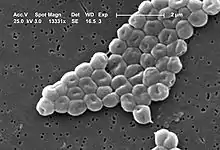Pseudomonadales
The Pseudomonadales are an order of Proteobacteria.[1] They are gram-negative. Some species can cause diseases, they are pathogen. For example, Pseudomonas aeruginosa can cause sepsis. Azomonas and Azotobacter are able to fix nitrogen.
| Pseudomonadales | |
|---|---|
 | |
| Acinetobacter baumannii | |
| Scientific classification | |
| Kingdom: | |
| Phylum: | |
| Class: | |
| Order: | Pseudomonadales Orla-Jensen, 1921 |
| Families and Genera | |
| |
Systematics
There are two families: The Moraxellaceae and Pseudomonadaceae.[2] Some examples:
- Moraxellaceae
- Acinetobacter
- Alkanindiges
- Enhydrobacter
- Moraxella
- Perlucidibaca
- Psychrobacter
- Pseudomonadaceae
- Azomonas
- Azorhizophilus
- Azotobacter
- Cellvibrio
- Mesophilobacter
- Pseudomonas
- Rhizobacter
- Rugamonas
References
- Garrity, George M.; et al. (2005). Bergey's manual of systematic bacteriology. Volume 2: The Proteobacteria, Part B: The Gammaproteobacteria.
- J.P. Euzéby: List of Prokaryotic Names with Standing in Nomenclature - Ordo Pseudomonadales Archived 2008-10-11 at the Wayback Machine
This article is issued from Wikipedia. The text is licensed under Creative Commons - Attribution - Sharealike. Additional terms may apply for the media files.